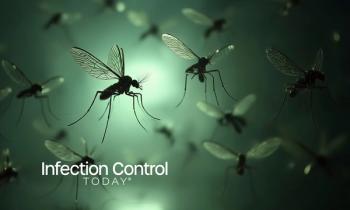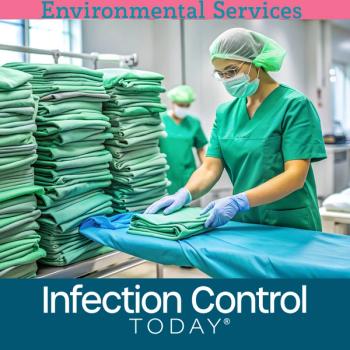
Infection Control Today - 06/2004: Aseptic Technique
Aseptic Technique
Best Practices in Real Life
By Kathy Dix
The Consequences of Sepsis
Talking about asepsis is all well and good, but we mustremember why this technique is so important. The end result of blood or tissue infection sepsis isa dramatic and often fatal result of poor aseptic practices. (See sidebar on page 50.)
Sepsis is defined as a severeillness caused by overwhelming infection of the bloodstream by toxin-producingbacteria. It occurs in two out of every 100 hospital admissions, and iscaused by infection that can originate anywhere in the body.1 Common sites of nosocomial sepsis include IV lines, surgical wounds and drains, and ulcers orbedsores. Its diagnosis can be confirmed via blood culture, although there maybe a negative result if the patient is on antibiotics.
Sepsis causes blood pressure to fall, which leads to shock,then to abnormal organ function. The earliest indicators of this infection areoften a change in mental status and hyperventilation. Other symptoms include fever, hypothermia, chills, warm skin,tachycardia and decreased urine output. White blood cell counts may be low orhigh and platelet counts low; blood gases may indicate acidosis.
Patients with sepsis often require care in the intensive careunit (ICU), with broad-spectrum intravenous antibiotics. Once the infection isidentified, antibiotics may be tailored to the specific causativeorganism.2
Mortality associated with sepsis can be as high as 60 percentif there are other medical problems involved. Of the three forms of sepsis uncomplicated sepsis, severe sepsis and septic shock severe sepsis carries amortality of 30 percent to 35 percent, and septic shock carries a mortality of50 percent.
Several steps are crucial to ensuring proper aseptictechnique:3
- Ensure antiseptics are being used properly.
- Ensure that regular in-services are being held and attended.
- Ensure that new staff undergoes orientation; this includes all job roles, including receptionists, medical staff and administrators.
- Ensure that you are acting as a proper role model to other staff members.
Appropriate antiseptics include chlorhexidine and iodophorsolutions; chlorhexidine works well for surgical hand scrubs and skinpreparation, but may irritate the genital area; iodophors are a better optionfor this area. Hexachlorophene and iodine solutions are not recommended forsurgical hand scrubs or for use on mucous membranes, according toEngenderHealth, an international nonprofit organization.
Sterile areas on a staff member who is gloved and gowned coverthe area from the chest to the level of the sterile field. Sleeves areconsidered sterile from 5 cm above the elbow to the cuff. On the patient, anyarea below the level of the draped patient is nonsterile.
Here are recommendations for ensuring that the sterile fieldremains so:
- Allow only sterile items within the sterile field.
- Do not contaminate items when they are opened, dispensed or transferred.
- Do not allow unsterile staff members within the sterilefield.
- Do not allow sterile staff members within the unsterilefield.
- Any sterile barrier that has been wet, cut or torn is now contaminated.
- When in doubt, throw it out.
According to the Association of periOperative RegisteredNurses (AORN), 2 million people acquire iatrogenic infections each year in theUnited States, and 90,000 people die. That statistic is shocking, especiallyconsidering how easy it is to prevent many of these infections. In the July 2003issue of AORN Journal, the association recommends that surgical siteinfections be prevented by administering prophylactic antibiotics and by notshaving the surgical site unless it is absolutely necessary to preventinterference with the incision. Not only that, but the association alsorecommends restricting risky activities such exposure to high personneltraffic and reminding other healthcare workers to wash their hands.
Considering the number of infections that occur inhospitals, raising the bar to reduce infection risks should be a top patientsafety priority. Each clinician is responsible for ensuring best practicerelated to infection control, the association recommends. Perioperative nurses mustremain vigilant about handwashing, scrubbing and gloving, and ensure that theseprocesses are performed according to standards.
In Practice
There are several misconceptions about aseptic techniquespecifically associated with the emergency department (ED) in many hospitals.One of these misconceptions is that all lines or procedures done in the ED aredirty and must be replaced, says Frank McGeorge, MD, an emergencyphysician and residency program director at William Beaumont Hospital in RoyalOak, Mich.
One needs to take the circumstances of its placement intoaccount, he states. Less emergently performed procedures are done with thesame care to aseptic techniques that we employ through the entire hospital. Intrue emergencies, though, we always have to balance the critical nature of thepatients condition with the time needed to perform all steps in a trulyaseptic fashion.
There is a second myth associated with the ED that the EDitself is dirtier than the rest of the hospital. Nurses and ancillary staffregularly clean rooms themselves during busier times, in addition to theconstant cleaning provided by housekeeping and environmental services, McGeorge says. Because of our rapid pace we are constantlycleaning, and as a result, the ED should be as clean as the rest of thehospital. The only variance to this is related to the unexpected nature ofemergencies. That is, we often have unexpected contamination of an areawhich can occur in an uncontrolled fashion such as when a patient suddenlyvomits blood or has diarrhea in their stretcher. In those cases, as soon as thepatient is stable, we begin the cleanup.
It is also untrue that emergency personnel just dont pay asmuch attention to aseptic technique, McGeorge maintains. This misconceptionis unjustified for two reasons, he explains. First, hospitals andemergency personnel recognize that reducing nosocomial infections begins at thefront door, which is what we represent. Policies and procedures for properidentification, triage and isolation of potentially communicable diseases existin all hospitals. We also know that in the case of blood culture sampling orline placement, our attention to proper aseptic technique has a farreachingimpact on the patients entire hospital course.
Secondly, because of our position at the front line,our exposure level to the unknown is higher and extra attention to aseptictechniques is also in our best interest as providers. The bottom line is,aseptic techniques are well known to all ED personnel and we consistently employthem, unless the risk to the patient of a delay in care due to aseptic technique(such as with a cardiac arrest or major trauma) outweighs the time necessary tofully comply with them. If it came down to having a lifesaving procedureperformed immediately in a clean way vs. waiting to have it done in a sterileway, most physicians agree the immediacy outweighs the benefit gained bysterility. It is better to be alive with a treatable infection than dead becauseof a delay in care. We are most interested in doing whats right for thepatient, and over 95 percent of the time, careful attention to aseptic technique is part ofthe answer. In the small minority, the emergent nature of the problemnecessitates attention to the patient before full attention to asepticprocedure, he clarifies.
The first misconception often leads to other departmentschanging a line as soon as the patient is moved out of the ED. There are somewho believe very strongly that any line placed in the ED should be consideredcontaminated until proven otherwise, or by default, says McGeorge. Emergencymedicine has come a long way, especially in larger centers, but I think even insmaller hospitals, to isolate patients that have potentially communicablediseases because of all of the threats, terror warnings, and all themiscellaneous health concerns that have come to light over the last severalyears we do go out of our way to isolate anybody who may be potentiallybiohazardous to patients around them. Theres certainly an increased awarenessof blood, body fluid and respiratory contamination, so the ED policy has beenset to specifically address those issues.
The one possible exception to the idea that the ED is not dirtieris in some departments that see a disproportionate number of indigent patientswho may have more highly-communicable diseases that would not necessarily becommon in a less underprivileged population, McGeorge concedes.
Under those circumstances, while I wouldnt consider theED to be dirtier, one would need to pay more attention to proper isolationtechniques and proper aseptic technique to prevent cross contamination, hesays.
The idea that the ED is a dirtier place is often portrayed bypopular television as well. Its popularized by shows like ER, wherethey do have some semblance of universal precautions, but they do also show manyscenes where blood and or body fluids are flying around in an uncontrolledfashion, and while thats not necessarily an unrealistic portrayal, what theydont show is the follow-through. We then decontaminate the area, we washhands very aggressively or change our clothes. So while they show thecontamination occurring, they dont show the cleanup occurring, because thecleanups not cool, McGeorge adds. There are time-sensitive issues thatmay prevent us from doing everything perfectly, but we certainly are aware ofthe issues, and we do whatever we can within the range of not only safety toother patients but safety to ourselves.
Regardless of the focus on proper technique, McGeorge pointsout that nobody is perfect. The formation and follow-through of bad habitsare human nature, and while we all may have been inserviced on the right thingto do, nobody is perfect all the time. Were all human, and we all do what weneed to in the patients best interest, weighing the risks and benefits athand. However, he says, it is possible to uphold proper aseptictechnique, if the facility is willing to take the time to prepare. In realestate, the motto is location, location, location, but in healthcare, itspreparation, preparation, preparation.
I think one of the most important elements to the use ofaseptic technique within an ED or throughout the hospital is easy access andready availability of supplies, observes McGeorge. Have handwash at thebedside, or have available either sterile or clean gloves at every bedside,masks, easy access to sterile or protective gowns. Those are all things we dobetter in the ED than anyplace else in the hospital, largely because we expectthose types of second-by-second, minute-by-minute needs more than inpatients do.For us, [supplies are] all at the bedside, in the bedside drawers, or theyreall in the resuscitation room where were working. So for us, its fareasier to access this equipment often than it would be for inpatient units. Thatsaid, we have more emergencies than they do, so our need for that relativedifference is higher. On the other hand, they do more elective procedures, wherethey have the luxury of time to gather all the equipment in a well-orchestratedfashion. Thats one of the things that sets the ED as a resource apart from other places. You always know where you can grab a pair ofsterile gloves, where you can grab the gloves, within seconds.
Preparation in the ED is ongoing; patient rooms and otherareas are restocked at least once at the beginning of every shift, andresuscitation areas are restocked immediately after resuscitation. In thecase of an endotracheal tube, or a thoracotomy tray, or a chest tube tray, thosethings would need to be restocked almost immediately because we dont keep aninfinite supply of them on hand. If theyre used, they would need to bereplaced. There are two good reasons this has to happen. One, first and foremostfor the patients safety, but truthfully, all of us in healthcare have avested interest in making sure that equipment is at the bedside because we arebeing exposed as well, so its just as much in our interest as it is in thepatients interest, he says.
Ensuring this flow means planning ahead, even as earlyas when the department is designed, placing sinks in multipleeasily-accessible locations, ideally in every room if possible, so you can washyour hands; the easy availability of waterless handwashing solution, the easyavailability of protective equipment, making sure that patients are properlytriaged into areas that are relatively either clean or dirty. If you have anarea dedicated to suturing lacerations, you would not want to take patients withabscesses and put them in those rooms. You would ideally put patients withinfected wounds in different rooms, so the risk of infecting otherwise cleanrooms would be reduced.
Ultimately, McGeorge says, Its attention to the detailof the chief compliant and attention to the patient. If a patient has obviouslyweeping oozing sores and their chief complaint is infection and fever, youwouldnt want to place that patient in an area where they could easily beexposed to other uninfected wounds. Aggressive environmental service detailingand/or housekeeping maintenance is very important.
At McGeorges hospital, the basic recommendations forenvironmental services are followed, but this is not to say that only theenvironmental services team is involved in cleaning. When McGeorge utilizes oneroom with a special ophthalmologic lamp, First, the area is cleaned after thepatient has used it; the area is cleaned before a new patient uses it. When Isee a patient, I assume that the person before may not have cleaned it off, so Iclean it off using an alcohol swab, and I put a protective barrier on it, eithera piece of tissue paper or some other protective barrier to add another layer. When Im done using it, I wipe it down again.
McGeorge continues, There are checks and balances, becauseyou make assumptions that nobodys perfect, human nature being what it is, andso you do have to have some built-in redundancy to cleaning techniques,especially in what would be an obviously chaotic and/or disruptive ornoncontiguous environment. Its not always the same people working in the samearea all the time. I may be seeing a patient in the eye room, and it may be oneof my partners six hours later using that room, and we dont know what theother person has done with it, which is very different from a doctors office,or an inpatient unit, where its the same providers using the same equipmentover and over again.
He concludes, I think the most important question to askis, If this were me, would I want to lay on that surface? Would I want to putmy chin there? Would I want this object touching my body? If the answer tothat is no, then clean it! You should do what youd want for yourselfand your family. It really is the golden rule. The golden rule gets followed asmuch as you can, to the limit of human nature and the time-sensitive nature ofsaving someones life.
Newsletter
Stay prepared and protected with Infection Control Today's newsletter, delivering essential updates, best practices, and expert insights for infection preventionists.





